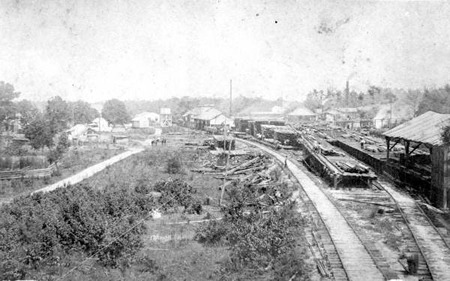Roughly midway between Live Oak in Suwannee County and Lee
in Madison County, Highway 90 crosses the Suwannee River, just south of the confluence
of the Suwannee and Withlacoochee rivers. At this location – on the Madison
County side of the rivers – a bustling community centered around a large timber
mill once existed. This community was founded in the late 1860s, when lumber
magnate George F. Drew (who would later become the 12th governor of Florida)
opened what was, at the time, the largest sawmill in the state of Florida. He
named it Ellaville, and according to legend this was to honor Ella, his
long-time African-American servant of that name. The area was covered in thick
forests of yellow pine ready to be harvested, and the combination of the rivers
and the fact that Ellaville was located along the railroad line connecting
Jacksonville and Tallahassee, made it easy to transport lumber to market. The combination
of the busy sawmill and the opulent residence of the state’s governor led Ellaville
to grow and thrive. At one point, in addition to the sawmill and the governor’s
mansion and the homes of the town’s several hundred residents, Ellaville
boasted a post office, train station, two schools, churches, a cemetery, stores,
a telegraph unit, and more. Additionally, the town’s location along the route
of the Old Spanish Trail / Old Bellamy Road / modern Highway 90 ensured regular
through-traffic, even in the horse-and-buggy days.
From here.
From here.
From here.
However, while trees are a renewable resource, they were not
planted and farmed in the late 1800s and early 1900s. Once the supply of trees
fueling the mill diminished, the community of Ellaville did as well. This,
combined with massive flooding, the Great Depression, and two successive world
wars slowly killed off the community. In 1942, the Ellaville post office closed
its doors for good, as there weren’t enough local residents to justify its
presence. Two of the few remaining landmarks of Ellaville were the distinctive
Suwannee River Store built in 1927, and the decaying remains of the
long-abandoned Drew mansion. However, the Drew mansion succumbed to arson in
1970, and repeated flooding and the re-routing of Highway 90 across a more
modern bridge to the west of Ellaville in 1986 led to the store being abandoned
as well.
From here.
From here.
Today, the modern “community” of Ellaville is located just
to the south of the Suwannee River, in Suwannee County. There you will find one
convenience store, and a law enforcement weigh-station. You can park and access
the old Hillman bridge from the Suwannee county side or the Madison county
side, although there is a parking lot with picnic tables on the Madison side. Of
the once bustling town of Ellaville on the Madison side of the river, there is
little sign, other than the parking lot, some historical markers, the overgrown
remains of the Suwannee River Store, and two private residences.
One of our readers suggested a while back that we should
check out the remains of the Governor Drew mansion in Ellaville, if we hadn’t
already… and since we had free time and glorious weather this past weekend, we
decided to do just that. We were not exactly successful. We found things,
certainly, interesting things, but we found neither the remains of the mansion
nor the cemetery, which were the two things we had really hoped to find and
photograph. We may have been thrown off the scent a bit by attempting to follow
the rather confusing directions of how to find said locations given to us by
one of the few remaining locals. C’est la vie. But like I said, just because we
didn’t find the mansion or the cemetery didn’t mean we didn’t find anything…
The road is closed to cars, but open to pedestrians and cyclists.
(Photo by JOM of Gravel Cyclist)
Could this be the remains of its boiler?
The following two videos were shot by Florida Trailblazer, and show the remains of the Drew mansion and cemetery, respectively:
The following links provide more information about Ellaville, past and present:





















Very cool. Thanks for the info and pics
ReplyDeleteI found the Ellaville (Edwards) Spring. I will share images, soon. It is just downstream on the southern bank of the Suwannee and Withlacoochee confluence, just downstream of the railroad tracks. It was well hidden. I see it only being accessible by the river.
ReplyDeleteI read someone's blog (and now I can't remember whose) about how they were able to get to it by land although they said they were "probably trespassing."
DeleteDo you by chance have a map reference or screenshot of the parking area that you parked at?
ReplyDeleteI went yesterday and found it. It's hard to find because of over growth, but possible never was able to find cemetery though.
ReplyDeleteKeep walking west past the mansion remains and the cemetery will be on your right. Just look for old headstones. Most where knocked over but still very cool to see.
DeleteI know where the cemetery and house were dlt1956@yahoo. com
ReplyDeleteI grew up just up river from Ellaville and the state park. In the '70s and early '80s the Suwannee River Store was a place called Pirateland, with a pirate/Old Spanish Trail touristy feel. It was a convenience store/bait shop/pool hall. The owner was our neighbor, Mrs. Porter. Fond memories!
ReplyDelete